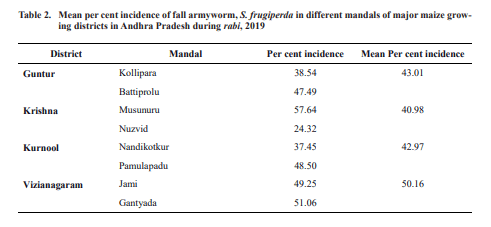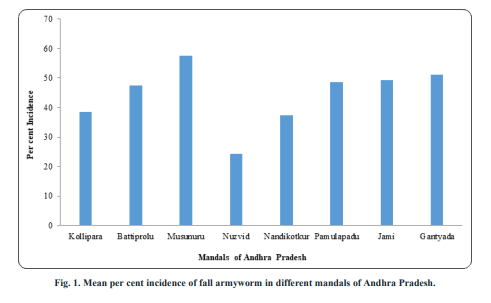Survey on Fall Armyworm, Spodoptera Frugiperda Incidence In Major Maize Growing Areas in Andhra Pradesh, India
0 Views
R. RAVINDREN*, N.C. VENKATESWARLU, G.S. PANDURANGA, V.L.N. REDDY AND
B. RAVINDRA REDDY
Department of Entomology, S.V. Agricultural College, ANGRAU, Tirupati
ABSTRACT
A field survey was conducted to record the incidence and infestation of fall armyworm, Spodoptera frugiperda on maize in various maize growing areas in Andhra Pradesh during rabi, 2019. The survey was undertaken in twenty four villages in four major maize growing districts of Andhra Pradesh. The per cent incidence of fall armyworm ranged from 13.44 per cent to 87.99 per cent. The maximum pest incidence was recorded from Pallekona village of Battiprolu mandal in Guntur district (87.99%) whereas the minimum incidence was recorded from Anamarajupeta village of Jami mandal in Vizianagaram district (13.44%). Among mandals, the mean per cent incidence of fall armyworm was highest in Musunuru mandal of Krishna district (57.64%) and the lowest incidence was recorded in Nuzvid mandal of Krishna district (24.32%). The mean per cent incidence of fall armyworm was recorded highest in Vizianagaram district (50.16%) and lowest incidence in Krishna district (40.98%).
KEY WORDS:
Andhra Pradesh, fall armyworm, maize, survey.
INTRODUCTION
Maize (Zea mays L.) being the second most important cereal crop in the world in terms of acreage is often called as “Queen of Cereals”. Global maize production touched 1147 million MT during 2018, wherein, USA has been the leading producer, followed by China, accounting for about 34 per cent and 22 per cent respectively. India contributes around 2.42 per cent of this production chart with a quantum of 28 million Metric tonnes in 2018 (Anonymous, 2018). India stands almost half the global production standards and therefore there is a great scope for improvement in the strategically important crop in the country. Maize is the only food cereal crop that can be grown in different seasons and requires moderate climatic condition for growth. According to industry estimates, India would require 45 million MT of Maize by the end of 2022, of which 30 million MT will be for feed and 15 million MT will be demanded by FSI (Food, Seed and Industry) (Maize vision 2022, FICCI). By 2050, the demand for maize will double in the developing world and maize is predicted to become the crop with the greatest production globally and in the developing world by 2025 (Rosegrant et al., 2009).
The yield potential of a cultivar when grown in field, experiences various biotic (diseases, insects and weeds) and abiotic (temperature, moisture, wind, etc.) constraints, which reduces quantity and quality of the produce, resulting in crop losses. Among insects, though there is report of 250 insects in maize ecosystem (Mathur, 1992) but important ones are the key native pests, viz., stemborers, Chilo partellus Swinhoe and Sesamia inferens Walker, sorghum shoot fly, Atherigona spp. and the recent invasive pest, fall armyworm Spodoptera frugiperda (J.E. Smith), etc.,
The fall armyworm (FAW), Spodoptera frugiperda (J.E. Smith) (Lepidoptera : Noctuidae) is a highly polyphagous migratory pest, native to the tropical and subtropical region of Americas. The FAW has a very wide host range and recorded on more than 353 host plants (Montezano et al., 2018). The pest distribution was restricted in the American continents till 2015. A severe outbreak of FAW in maize was reported from African countries in 2016 (Goergen et al., 2016). In 2018, mid- May, the occurrence of invasive fall armyworm on maize has been first reported in Karnataka, India (Sharanabasappa et al., 2018; Ganiger et al., 2018 and Shylesha et al., 2018).
In just two years since introduction, FAW has spread across all the maize growing states of our country, except the states of Himachal Pradesh and Jammu and Kashmir. In Andhra Pradesh, the pest was first sighted in Vishakapatnam, Srikakulam and Vizianagaram Districts in August 2018. Maize is an emerging second most important cereal crop after rice in Andhra Pradesh and it is necessary to know the incidence of the FAW among different districts of the state. Keeping the above in view, surveys were conducted to record the per cent incidence of fall armyworm in major maize growing districts of Andhra Pradesh.
MATERIAL AND METHODS
Roving survey was conducted in major maize growing areas in Andhra Pradesh during rabi, 2019 to observe the incidence of fall armyworm on maize. Four major maize growing districts were selected for survey on fall armyworm incidence viz., Guntur, Krishna, Kurnool and Vizianagaram. In each district, two mandals were selected and in each mandal, three villages were chosen. In each village, two farmer fields were selected for survey. The list of mandals and villages surveyed are mentioned in Table 1.
In each farmer field, ten sampling units of 1 m2 each were selected for survey. In each sampling unit, data on total number of plants and total number of damaged plants were recorded for calculating the per cent incidence of pest in the field.

Simple statistical tools like frequency, mean and percentage were used to analyse the data using Microsoft Excel 2010 spread sheet.
RESULTS AND DISCUSSION
The per cent incidence of fall armyworm in various maize growing villages of Andhra Pradesh was given in Table 1 and the incidence ranged from 13.44 per cent to
87.99 per cent. The maximum pest incidence was recorded from Pallekona village of Battiprolu mandal in Guntur district (87.99%) whereas the minimum incidence was recorded from Anamarajupeta village of Jami mandal in Vizianagaram district (13.44%).
The mean per cent incidence of fall armyworm in different mandals was mentioned in Table 2. The mean per cent incidence of fall armyworm in Kollipara and Battiprolu mandals of Guntur district were 38.54 per cent and 47.49 per cent respectively. However, the mean per cent incidence was 57.64 per cent and 24.32 per cent in Musunuru and Nuzvid mandals of Krishna district respectively, exhibiting huge difference of pest incidence within the district. In Nandikotkur and Pamulapadu mandals of Kurnool district, the per cent incidence were
37.45 per cent and 48.50 per cent respectively whereas in Vizianagaram district, the per cent incidence of fall armyworm was 49.25 per cent and 51.06 per cent in Jami and Gantyada mandals respectively. Among the mandals surveyed, the mean per cent incidence of fall armyworm was highest in Musunuru mandal of Krishna district (57.64%) whereas the lowest incidence was recorded in Nuzvid mandal of Krishna district (24.32%).
The mean per cent incidence of fall armyworm in four maize growing districts of Andhra Pradesh was mentioned in Table 3. Among the districts, the mean per cent incidence of S. frugiperda was recorded highest in Vizianagaram district (50.16%) followed by Guntur district (43.01%) and Kurnool district (42.97%). The lowest mean per cent incidence of fall armyworm was recorded in Krishna district (40.98%).
The per cent FAW incidence reported during the survey are in confirmatory with the studies conducted by Visalakshi et al. (2019) in Andhra Pradesh, where the per cent incidence of fall armyworm ranged between 5 to 100 per cent with maximum incidence recorded from Vizianagaram district. Shylesha et al. (2018) also reported the range of per cent incidence of fall armyworm was 9 to 62 per cent which is in confirmation with the results during survey. The present results are also in line with the studies conducted by Mallapur et al. (2018), who reported that the per cent incidence of fall armyworm was ranged from 6 to 100 per cent.
SUMMARY AND CONCLUSION
The destructive invasive pest, fall armyworm extended its spread to various other crops including sorghum, ragi, sugarcane and bajra in Andhra Pradesh. It has become mandatory to conduct surveys to understand the incidence of the pest and its extent of damage in crops other than maize. Timely plant protection measures can control the pest from causing severe economic damage



for which efforts should be taken on early warning of the pest by forecasting using proper surveys and surveillances.
ACKNOWLEDGEMENT
We are thankful to the Department of Entomology and farm superintendent of S.V. Agricultural college, Tirupati for the timely help in conducting this study. This study is a part of M.Sc. Thesis of the first author.
LITERATURE CITED
Anonymous, 2018. https://apeda.gov.in.
Ganiger, P.C., Yeshwanth, H.M., Muralimohan, K., Vinay, N., Kumar, A.R.V and Chandrashekara, K. 2018. Occurrence of the new invasive pest, fall armyworm, Spodoptera frugiperda (J.E. Smith) (Lepidoptera : Noctuidae), in the maize fields of Karnataka, India. Current Science. 115(4): 621-623.
Goergen, G., Kumar, P.L., Sankung, S.B., Togola, A and Tamò, M. 2016. First Report of Outbreaks of the Fall Armyworm, Spodoptera frugiperda (J E Smith) (Lepidoptera : Noctuidae), a New Alien Invasive Pest in West and Central Africa. PLOS ONE, 11(10).
Maize vision 2022, FICCI. 2018. India-Maize-Summit. http://ficci.in/spdocument/22966/ India-Maize- Summit.pdf.
Mallapur, C.P., Naik, A.J., Hagari, S., Prabhu, S.T and Patil, R.K. 2018. Status of alien pest fall armyworm, Spodoptera frugiperda (J.E. Smith) on maize in Northern Karnataka. Journal of Entomology and Zoology Studies. 6(6): 432-436.
Mathur, L.M.L. 1992. Insect pest management and its future in Indian maize programme. XIX International Congress of Entomology, June 27-July 4, Bejing, China.
Montezano, D.G., Specht, A., Sosa-Gómez, D.R., Roque Specht, V.F., Sousa-Silva, J.C., Paula-Moraes, S.V. 2018. Host plants of Spodoptera frugiperda (Lepidoptera : Noctuidae) in the Americas. African Entomology. 26(2): 286-300.
Rosegrant, M.R., Ringler, C., Sulser, T.B., Ewing, M., Palazzo, A and Zhu, T. 2009. Agriculture and food security under global change: Prospects for 2025/ 2050. Washington, D.C: International Food Policy Research Institute.
Sharanabasappa, Kalleshwaraswamy, C.M., Asokan, R., Mahadevaswamy, H.M., Maruthi, M.S., Pavithro, H.B., Hegde, K., Navi, S., Prabhu, S.T and Goergin,
G. 2018. First report of fall army worm, Spodoptera frugiperda (J.E. Smith) (Lepidoptera : Noctuidae) an alien invasive pest on maize in India. Pest Management in Horticultural Ecosystems. 24(1): 23- 29.
Shylesha., A.N., Jalali., S.K., Gupta, A., Varshney, R., Venkatesan, T., Shetty, P., Ojha, R., Ganiger, P.C., Navik, O.,
Subaharan, K., Bakthavatsalam, N and Ballal, C.R. 2018 Studies on new invasive pest Spodoptera frugiperda (J. E. Smith) (Lepidoptera : Noctuidae) and its natural enemies. Journal of Biological Control. 32(3): 1-7.
Visalakshi, M., Ashika, T.R., Venkatesan, T., Ballal, C.R., Laxman, K., Nagarjuna, D., Chittibabu, G., Venkatarao, P and Jamuna, P. 2019. Report of the invasive fall armyworm, Spodoptera frugiperda (J.E. Smith) (Lepidoptera: Noctuidae) and its natural enemies on maize and other crops from Andhra Pradesh, India. Journal of Entomology and Zoology Studies. 7(4): 1348-1352.
- Bio-Formulations for Plant Growth-Promoting Streptomyces SP.
- Brand Preference of Farmers for Maize Seed
- Issues That Consumer Experience Towards Online Food Delivery (Ofd) Services in Tirupati City
- Influence of High Density Planting on Yield Parameters of Super Early and Mid Early Varieties of Redgram (Cajanus Cajan (L.) Millsp.)
- Influence of Iron, Zinc and Supplemental N P K on Yield and Yield Attributes of Dry Direct Sown Rice
- Effect of Soil and Foliar Application of Nutrients on the Performance of Bold Seeded Groundnut (Arachis Hypogaea L.)

